Published On:Wednesday, 14 December 2011
Posted by Muhammad Atif Saeed
Operating Assets
Operating Assets Defined
Operating assets are long-lived assets that are used in normal business operations. They are not held for resale to customers. Investments in operating assets are essential to the success of most businesses. There are three major categories of operating assets: property, plant, and equipment, sometimes referred to as plant assets or fixed assets; natural resources; and intangible assets. Property, plant, and equipment includes land; land improvements, such as driveways, parking lots, fences, and similar items that require periodic repair and replacement; buildings; equipment; vehicles; and furniture. Natural resources, such as timber, fossil fuels, and mineral deposits, are created by natural processes that may take thousands or even millions of years to complete. Companies use up natural resources by cutting or extracting them, so natural resources are sometimes called wasting assets. Intangible assets, which lack physical substance, may nevertheless provide substantial value to a company. Patents, copyrights, and trademarks are examples of intangible assets.
According to the matching principle, the costs of operating assets other than land must be matched with the revenues they help to generate over their useful lives. Allocating these costs to expense is called depreciation for plant assets, depletion for natural resources, and amortization for intangible assets. The cost of land is never depreciated because land is considered to have an unlimited useful life.
Natural resources are usually listed within the property, plant, and equipment category on the balance sheet. Intangible assets are placed in a separate category.
Digby Pitts Strip Mining Partial Balance Sheet December 31, 20X4
|
The Cost of Property, Plant, Equipment
The cost of property, plant, and equipment includes the purchase price of the asset and all expenditures necessary to prepare the asset for its intended use.
Land. Land purchases often involve real estate commissions, legal fees, bank fees, title search fees, and similar expenses. To be prepared for use, land may need to be cleared of trees, drained and filled, graded to remove small hills and depressions, and landscaped. In addition, old buildings may need to be demolished before the company can use the land. Such demolition expenses are considered part of the land's cost. For example, if a company purchases land for $100,000, pays an additional $3,000 in closing costs, and pays $22,000 to have an old warehouse on the land demolished, then the company records the cost of the land at $125,000.
Land improvements. The cost of land improvements includes all expenditures associated with making the improvements ready for use. For example, when one business contracts with another business to put a parking lot on a piece of land, the cost of the parking lot is simply the agreed-upon price. A company that builds its own parking lot would determine the lot's cost by combining the cost of materials and wages paid to employees for building the lot.
Buildings. The cost of buildings includes the purchase price and all closing costs associated with the acquisition of the buildings, including payments by the purchaser for back taxes owed. Remodeling an acquired building and making repairs necessary for it to be used are also considered part of the cost. If a building is constructed for the company over an extended period, interest payments to finance the structure are included in the cost of the asset only while construction takes place. After construction is complete and the building is ready for productive use, interest payments are classified as interest expense.
Equipment, vehicles, and furniture. The cost of equipment, vehicles, and furniture includes the purchase price, sales taxes, transportation fees, insurance paid to cover the item during shipment, assembly, installation, and all other costs associated with making the item ready for use. These costs do not include such things as motor vehicle licensing and insurance, however, even if they are paid when a vehicle purchase occurs. Expenses of this type are normal, recurring operational expenses that do not add lasting value to the vehicle.
Depreciation of Operating Assets
Depreciation is the process of allocating the cost of long-lived plant assets other than land to expense over the asset's estimated useful life. For financial reporting purposes, companies may choose from several different depreciation methods. Before studying some of the methods that companies use to depreciate assets, make sure you understand the following definitions.
Useful life is an estimate of the productive life of an asset. Although usually expressed in years, an asset's useful life may also be based on units of activity, such as items produced, hours used, or miles driven.
Depreciable cost equals an asset's total cost minus the asset's expected salvage value. The total amount of depreciation expense assigned to an asset never exceeds the asset's depreciable cost.
Net book value is an asset's total cost minus the accumulated depreciation assigned to the asset. Net book value rarely equals market value, which is the price someone would pay for the asset. In fact, the market value of an asset, such as a building, may increase while the asset is being depreciated. Net book value simply represents the portion of an asset's cost that has not been allocated to expense.
Straight-line depreciation. There are many depreciation methods available to companies. Straight-line depreciation is the method that companies most frequently use for financial reporting purposes. If straight-line depreciation is used, an asset's annual depreciation expense is calculated by dividing the asset's depreciable cost by the number of years in the asset's useful life.
|
Another way to describe this calculation is to say that the asset's depreciable cost is multiplied by the straight-line rate, which equals one divided by the number of years in the asset's useful life.
Calculating Straight-Line Depreciation
|
Suppose a company purchases a $90,000 truck and expects the truck to have a salvage value of $10,000 after five years. The depreciable cost of the truck is $80,000 ($90,000 – $10,000), and the asset's annual depreciation expense using straight-line depreciation is $16,000 ($80,000 ÷ 5).
|
|
The following table summarizes the application of straight-line depreciation during the truck's five-year useful life.
| ||||||||||||||||||||||||||||||||||||||||||||||||||||||||||||||||
At the end of year five, the $80,000 shown as accumulated depreciation equals the asset's depreciable cost, and the $10,000 net book value represents its estimated salvage value.
To record depreciation expense on the truck each year, the company debits depreciation expense–vehicles for $16,000 and credits accumulated depreciation–vehicles for $16,000.
 |
If another depreciation method had been used, the accounts that appear in the entry would be the same, but the amounts would be different.
Companies use separate accumulated depreciation accounts for buildings, equipment, and other types of depreciable assets. Companies with a large number of depreciable assets may even create subsidiary ledger accounts to track the individual assets and the accumulated depreciation on each asset.
 |
Units-of-activity depreciation. The useful life of some assets, particularly vehicles and equipment, is frequently determined by usage. For example, a toy manufacturer may expect a certain machine to produce one million dolls, or an airline may expect an airplane to provide ten thousand hours of flight time. Units-of-activity depreciation, which is sometimes called units-of-production depreciation, allocates the depreciable cost of an asset based on its usage. A per-unit cost of usage is found by dividing the asset's depreciable cost by the number of units the asset is expected to produce or by total usage as measured in hours or miles. The per-unit cost times the actual number of units in one year equals the amount of depreciation expense recorded for the asset that year.
Calculating Units-of-Activity Depletion
|
If a truck with a depreciable cost of $80,000 ($90,000 cost less $10,000 estimated salvage value) is expected to be driven 400,000 miles during its service life, the truck depreciates $0.20 each mile ($80,000 ÷ 400,000 miles = $0.20 per mile). The following table shows how depreciation expense is assigned to the truck based on the number of miles driven each year.
| ||||||||||||||||||||||||||||||||||||||||||||||||||||||||||||||||
Sum-of-the-years'-digits depreciation. Equipment and vehicles often provide greater benefits when they are new than when they approach the end of their useful lives and more frequently require repairs. Using sum-of-the-years'-digits depreciation is one way for companies to assign a disproportionate share of depreciation expense to the first years of an asset's useful life. Under this method, depreciation expense is calculated using the following equation.
Calculating Sum-of-Year's-Digits Depletion
|
The equation's denominator (the sum of the years' digits) can be found by adding each integer from one through the number of years in the asset's useful life (1 + 2 + 3…) or by substituting the number of years in the asset's useful life for x in the following equation.
|
The sum of the years' digits for an asset with a five-year useful life is 15.
|
Therefore, depreciation expense on the asset equals five-fifteenths of the depreciable cost during the first year, four-fifteenths during the second year, three-fifteenths during the third year, two-fifteenths during the fourth year, and one-fifteenth during the last year.
The following table shows how the sum-of-the-years'-digits method allocates depreciation expense to the truck, which has a depreciable cost of $80,000 ($90,000 cost less $10,000 expected salvage value) and a useful life of five years.
| ||||||||||||||||||||||||||||||||||||||||||||||||||||||||||||||||
Declining-balance depreciation. Declining-balance depreciation provides another way for companies to shift a disproportionate amount of depreciation expense to the first years of an asset's useful life. Declining-balance depreciation is found by multiplying an asset's net book value (not its depreciable cost) by some multiple of the straight-line rate for the asset. The straight-line rate is one divided by the number of years in the asset's useful life. Companies typically use twice (200%) the straight-line rate, which is called the double-declining-balance rate, but rates of 125%, 150%, or 175% of the straight-line rate are also used. Once the declining-balance depreciation rate is determined, it stays the same for the asset's useful life.
Calculating Declining-Balance Deprciation
|
To illustrate double-declining-balance depreciation, consider the truck that has a cost of $90,000, an expected salvage value of $10,000, and a five-year useful life. The truck's net book value at acquisition is also $90,000 because no depreciation expense has been recorded yet. The straight-line rate for an asset with a five-year useful life is 20% (1 ÷ 5 = 20%), so the double-declining-balance rate, which uses the 200% multiple, is 40% (20% x 200% = 40%). The following table shows how the double-declining-balance method allocates depreciation expense to the truck.
| ||||||||||||||||||||||||||||||||||||||||||||||||||||||||
At the end of an asset's useful life, the asset's net book value should equal its salvage value. Although 40% of $11,664 is $4,666, the truck depreciates only $1,664 during year five because net book value must never drop below salvage value. If the truck's salvage value were $5,000, depreciation expense during year five would have been $6,664. If the truck's salvage value were $20,000, then depreciation expense would have been limited to $12,400 during year three, and no depreciation expense would be recorded during year four or year five.
Comparing depreciation methods. All depreciation methods are designed to systematically allocate the depreciable cost of an asset to expense during the asset's useful life. Although total depreciation expense is the same no matter what depreciation method is used, the methods differ from each other in the specific assignment of depreciation expense to each year or accounting period, as shown in the following comparison of annual depreciation expense over five years using a truck's depreciable cost of $80,000.
| ||||||||||||||||||||||||||||||||||||||||
The sum-of-the-years'-digits and double-declining-balance methods are called accelerated depreciation methods because they allocate more depreciation expense to the first few years of an asset's life than to its later years.
Partial-year depreciation calculations. Partial-year depreciation expense calculations are necessary when depreciable assets are purchased, retired, or sold in the middle of an annual accounting period or when the company produces quarterly or monthly financial statements. The units-of-activity method is unaffected by partial-year depreciation calculations because the per-unit depreciation expense is simply multiplied by the number of units actually used during the period in question. For all other depreciation methods, however, annual depreciation expense is multiplied by a fraction that has the number of months the asset depreciates as its numerator and twelve as its denominator. Since depreciation expense calculations are estimates to begin with, rounding the time period to the nearest month is acceptable for financial reporting purposes.
Suppose the truck is purchased on July 26 and the company's annual accounting period ends on December 31. The company must record five months of depreciation expense on December 31 (August-December).
Under the straight-line method, the first full year's annual depreciation expense of $16,000 is multiplied by five-twelfths to calculate depreciation expense for the truck's first five months of use. $16,000 of depreciation expense is assigned to the truck in each of the next four years, and seven months of depreciation expense is assigned to the truck in the following year.
| ||||||||||||||||||||||||||||||||||||||||||||||||||||||||||||||||||||||||
Under the declining-balance method, the first full year's annual depreciation expense of $36,000 is multiplied by five-twelfths to calculate depreciation expense for the truck's first five months of use. In subsequent years, the truck's net book value is higher than it would have been if a full year's depreciation expense had been assigned during the first year, but the declining-balance method's calculation of depreciation expense is otherwise unchanged.
| ||||||||||||||||||||||||||||||||||||||||||||||||||||||||||||||||
Under the sum-of-the-years'-digits method, the first full year's annual depreciation expense of $26,667 is multiplied by five-twelfths to calculate depreciation expense for the truck's first five months of use. During the second year, depreciation expense is calculated in two steps. The remaining seven-twelfths of the first full year's annual depreciation expense of $26,667 is added to five-twelfths of the second full year's annual depreciation expense of $21,333. This two-step calculation continues until the truck's final year of use, at which time depreciation expense is calculated by multiplying the last full year's annual depreciation expense of $5,333 by seven-twelfths.
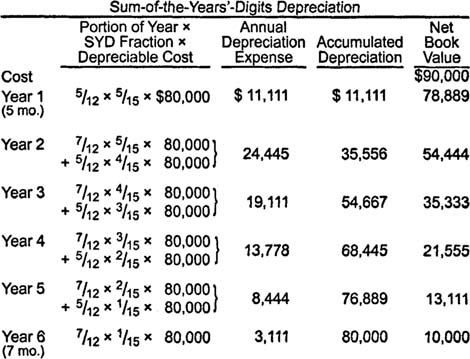 |
Revising depreciation estimates. Depreciation expense calculations depend upon estimates of an asset's useful life and expected salvage value. As time passes, a number of factors may cause these estimates to change. For example, after recording three years of depreciation expense on the truck, suppose the company decides the truck should be useful until it is seven rather than five years old and that its salvage value will be $14,000 instead of $10,000. Prior financial statements are not changed when useful life or salvage value estimates change, but subsequent depreciation expense calculations must be based upon the new estimates of the truck's useful life and depreciable cost.
Under the straight-line method, depreciation expense for years four through seven is calculated according to the following equation.
Revising Straight-Line Deprciation
|
Assume that the company purchased the truck at the beginning of an annual accounting period. The previous table shows how depreciation expense was calculated during the truck's first three years of use. The truck's net book value of $42,000 at the end of year three is reduced by the new, $14,000 estimate of salvage value to produce a revised depreciable cost of $28,000. The revised depreciable cost is divided by the four years now estimated to remain in the truck's useful life, yielding annual depreciation expense of $7,000.
|
Similar revisions are made for each of the other depreciation methods. The asset's net book value when the revision is made along with new estimates of salvage value and useful life—measured in years or units—are used to calculate depreciation expense in subsequent years.
Depreciation for income tax purposes. In the United States, companies frequently use one depreciation method for financial reporting purposes and a different method for income tax purposes. Tax laws are complex and tend to change, at least slightly, from year to year. Therefore, this book does not attempt to explain specific income tax depreciation methods, but it is important to understand why most companies choose different income tax and financial reporting depreciation methods.
For financial reporting purposes, companies often select a depreciation method that apportions an asset's depreciable cost to expense in accordance with the matching principle. For income tax purposes, companies usually select a depreciation method that reduces or postpones taxable income and, therefore, tax payments. In the United States, straight-line depreciation is the method companies most frequently use for financial reporting purposes, and a special type of accelerated depreciation designed for income tax returns is the method they most frequently use for income tax purposes.
Repairs and Improvements
Expenses relating to depreciable assets fall into two broad categories: ordinary expenditures and capital expenditures. Ordinary expenditures include normal repairs, maintenance, and upkeep. The costs associated with these items are considered normal operating expenses, and they are recorded by debiting expense accounts and crediting cash or another appropriate account. Capital expenditures increase an asset's usefulness or service life, and they are recognized by increasing the asset's net book value.
There are two ways to increase an asset's net book value: the asset account can be debited, thus increasing the recognized cost of the asset, or the asset's corresponding accumulated depreciation account can be debited, thus decreasing the amount of depreciation previously allocated to the asset. If the capital expenditure serves primarily to increase the asset's usefulness or value, the asset account should be debited. On the other hand, if the capital expenditure serves primarily to increase the asset's useful life or salvage value, the accumulated depreciation account should be debited. Such judgments are not always clear cut, and discussions about the best way to record capital expenditures are usually covered in more advanced accounting courses. Nevertheless, you should be prepared to see capital expenditures recorded in either the asset account or the asset's accumulated depreciation account, and you should recognize that the effect on the asset's net book value is the same either way. Consider how a $10,000 capital expenditure changes the truck's net book value.
|
When capital expenditures are made, the revised net book value must be used to calculate depreciation expense in subsequent accounting periods.
Disposition of Depreciable Assets
Depreciable assets are disposed of by retiring, selling, or exchanging them. When a depreciable asset is disposed of, an entry is made to recognize any unrecorded depreciation expense up to the date of the disposition, and then the asset's cost and accumulated depreciation are removed from the respective general ledger accounts. Any recognized losses or gains associated with the disposition are recorded in a separate account and appear in the portion of the income statement named other income/(expense), net.
Music World Partial Income Statement For the Year Ended June 30, 20X3
| Operating Income | ||
| Other lncome/(Expense), Net | 245,500 | |
| Interest Income | $ 7,500 | |
| Gain on Sale of Equipment | 1,500 | |
| Interest Expense | (18,000) | |
| Other lncome/(Expense), Net | (9,000) | |
| Net Income | $236,500 |
Retirement of depreciable assets. Retirement occurs when a depreciable asset is taken out of service and no salvage value is received for the asset. In addition to removing the asset's cost and accumulated depreciation from the books, the asset's net book value, if it has any, is written off as a loss.
Suppose the $90,000 truck reaches the end of its useful life with a net book value of $10,000, but the truck is in such poor condition that a salvage yard simply agrees to haul it away for free. The entry to record the truck's retirement debits accumulated depreciation-vehicles for $80,000, debits loss on retirement of vehicles for $10,000, and credits vehicles for $90,000. The loss is considered an expense and decreases net income.
 |
A gain never occurs when an asset is retired. If the entire cost of an asset has been depreciated before it is retired, however, there is no loss. For example, if the company using the truck had expected no salvage value and, therefore, had allocated $90,000 in depreciation expense to the truck before its retirement, the disposition would be recorded simply by debiting accumulated depreciation-vehicles for $90,000 and crediting vehicles for $90,000.
 |
Sale of depreciable assets. If an asset is sold for cash, the amount of cash received is compared to the asset's net book value to determine whether a gain or loss has occurred. Suppose the truck sells for $7,000 when its net book value is $10,000, resulting in a loss of $3,000. The sale is recorded by debiting accumulated depreciation-vehicles for $80,000, debiting cash for $7,000, debiting loss on sale of vehicles for $3,000, and crediting vehicles for $90,000.
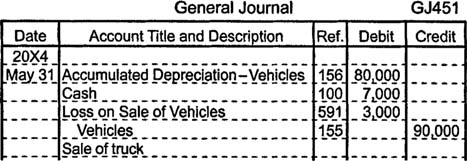 |
If the truck sells for $15,000 when its net book value is $10,000, a gain of $5,000 occurs. The sale is recorded by debiting accumulated depreciation-vehicles for $80,000, debiting cash for $15,000, crediting vehicles for $90,000, and crediting gain on sale of vehicles for $5,000.
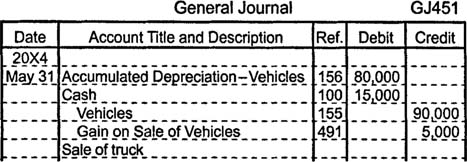 |
Exchange of depreciable assets. Certain types of assets, particularly vehicles and large pieces of equipment, are frequently exchanged for other tangible assets. For example, an old vehicle and a negotiated amount of cash may be exchanged for a new vehicle.
There are two types of exchanges: similar exchanges and dissimilar exchanges. A similar exchange involves the exchange of one asset for another asset that performs the same type of function. Trading in an old delivery truck to purchase a new delivery truck is an example of a similar exchange. A dissimilar exchange, which is less common than a similar exchange, involves the exchange of one asset for another asset that performs a different function. Trading in an old truck for a forklift is an example of a dissimilar exchange.
Suppose a $90,000 delivery truck with a net book value of $10,000 is exchanged for a new delivery truck. The company receives a $6,000 trade-in allowance on the old truck and pays an additional $95,000 for the new truck, so a loss on exchange of $4,000 must be recognized.
|
The cost of the new truck is $101,000 ($95,000 cash + $6,000 trade-in allowance). Therefore, the exchange is recorded by debiting vehicles for $101,000 (to record the new truck's cost), debiting accumulated depreciation-vehicles for $80,000 (to remove the old truck's accumulated depreciation from the books), debiting loss on exchange of vehicles for $4,000, crediting vehicles for $90,000 (to remove the old truck from the books), and crediting cash for $95,000.
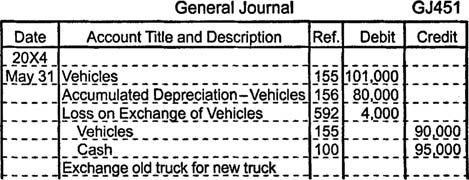 |
If the company exchanges its used truck for a forklift, receives a $6,000 trade-in allowance, and pays $20,000 for the forklift, the loss on exchange is still $4,000. Assuming the company uses a separate account to record the cost of forklifts, the journal entry to record this dissimilar exchange debits forklifts for $26,000, debits accumulated depreciation-vehicles for $80,000, debits loss on exchange of vehicles for $4,000, credits vehicles for $90,000, and credits cash for $20,000.
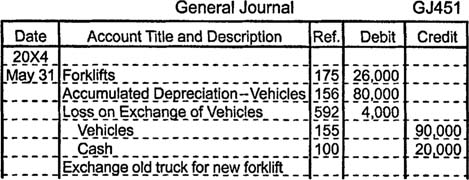 |
If the company receives a $12,000 trade-in allowance, a gain of $2,000 occurs.
|
Gains on similar exchanges are handled differently from gains on dissimilar exchanges. On a similar exchange, gains are deferred and reduce the cost of the new asset. For example, after receiving a $12,000 trade-in allowance on a delivery truck with a net book value of $10,000 and paying $89,000 in cash for a new delivery truck, the company records the cost of the new truck at $99,000 instead of $101,000. The $99,000 cost of the new truck equals the $12,000 trade-in allowance plus the $89,000 cash payment minus the $2,000 gain. Since the $12,000 trade-in allowance minus the $2,000 gain equals the old truck's net book value of $10,000, however, it is easier to think of the $99,000 cost as being equal to the old truck's net book value of $10,000 plus the $89,000 paid in cash. To record this exchange, the company debits vehicles for $99,000 (to record the new truck's recognized cost), debits accumulated depreciation-vehicles for $80,000 (to remove the old truck's accumulated depreciation from the books), credits vehicles for $90,000 (to remove the old truck from the books), and credits cash for $89,000.
 |
Gains on dissimilar exchanges are recognized when the transaction occurs. After receiving a $12,000 trade-in allowance on a truck with a $10,000 net book value and paying $14,000 in cash for a forklift, the company debits forklifts for $26,000, debits accumulated depreciation-vehicles for $80,000, credits vehicles for $90,000, credits cash for $14,000, and credits gain on exchange of vehicles for $2,000.
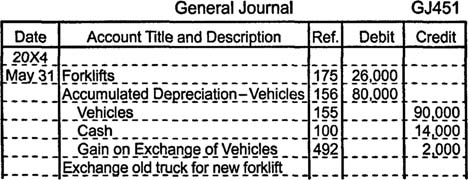 |
Natural Resources
Timber, fossil, mineral deposits, and other natural resources are different from depreciable assets because they are physically extracted during company operations and they are replaceable only through natural processes.
Cost of natural resources. The cost of natural resources includes all costs necessary to acquire the resource and prepare it for extraction. If the property must be restored after the natural resources are removed, the restoration costs are also considered to be part of the cost.
Companies that search for new natural resources determine cost using one of two approaches: the successful-efforts approach or the full-cost approach. Under the successful-efforts approach, exploration costs are considered part of the cost of natural resources only when a productive natural resource is found. Unsuccessful exploration costs are treated as expenses in the period during which they occur. Under the full-cost approach, all exploration costs are included in the cost of natural resources. The approach that a company selects should be disclosed in the notes that accompany the financial statements.
Depletion. Depletion is the process of allocating the depletable cost of natural resources to expense as individual units of the resource are extracted. Depletable cost equals the total cost of natural resources less any salvage value remaining after the company finishes extracting them. Depletion expense is generally calculated using the units-of-activity method. Under this method, a per-unit cost of depletion is found by dividing the depletable cost by the estimated number of units the resource contains. The per-unit cost times the actual number of units extracted and sold in one year equals the amount of depletion expense recorded for the asset during that year.
Calculating Units-of-Activity Depletion
|
Suppose a company pays $50,000,000 for an existing gold mine estimated to contain 1,000,000 ounces of gold. The mine has no salvage value, so the depletable cost of $50,000,000 is divided by 1,000,000 ounces to calculate a per-unit depletion cost of $50 per ounce. If the company extracts and then sells 100,000 ounces of gold during the year, depletion expense equals $5,000,000.
Calculating Units-of-Activity Depletion
|
One way to record depletion expense of $5,000,000 is to debit depletion expense for $5,000,000 and credit accumulated depletionmine for $5,000,000.
 |
Instead of using a contra-asset account to record accumulated depletion, companies may also decrease the balance of natural resources directly. Therefore, depletion expense of $5,000,000 might be recorded by debiting depletion expense for $5,000,000 and crediting the gold mine for $5,000,000.
 |
Intangible Assets
Intangible assets include patents, copyrights, trademarks, trade names, franchise licenses, government licenses, goodwill, and other items that lack physical substance but provide long-term benefits to the company. Companies account for intangible assets much as they account for depreciable assets and natural resources. The cost of intangible assets is systematically allocated to expense during the asset's useful life or legal life, whichever is shorter, and this life is never allowed to exceed forty years. The process of allocating the cost of intangible assets to expense is called amortization, and companies almost always use the straight-line method to amortize intangible assets.
Patents. Patents provide exclusive rights to produce or sell new inventions. When a patent is purchased from another company, the cost of the patent is the purchase price. If a company invents a new product and receives a patent for it, the cost includes only registration, documentation, and legal fees associated with acquiring the patent and defending it against unlawful use by other companies. Research and development costs, which are spent to improve existing products or create new ones, are never included in the cost of a patent; such costs are recorded as operating expenses when they are incurred because of the uncertainty surrounding the benefits they will provide.
The legal life of a patent is seventeen years, which often exceeds the patent's useful life. Suppose a company buys an existing, five-year-old patent for $100,000. The patent's remaining legal life is twelve years. If the company believes the patent's remaining useful life is only ten years, they use the straight-line method to calculate that $10,000 ($100,000 ÷ 10 = $10,000) must be recorded as amortization expense each year.
One way to record amortization expense of $10,000 is to debit amortization expense for $10,000 and credit accumulated amortization-patent for $10,000.
 |
Instead of using a contra-asset account to record accumulated amortization, most companies decrease the balance of the intangible asset directly. In such cases, amortization expense of $10,000 is recorded by debiting amortization expense for $10,000 and crediting the patent for $10,000.
 |
A similar entry would be made to record amortization expense for each type of intangible asset. The entry would include a debit to amortization expense and a credit to the accumulated amortization or intangible asset account.
Copyrights. Companies amortize a variety of intangible assets, depending on the nature of the business. Copyrights provide their owner with the exclusive right to reproduce and sell artistic works, such as books, songs, or movies. The cost of copyrights includes a nominal registration fee and any expenditures associated with defending the copyright. If a copyright is purchased, the purchase price determines the amortizable cost. Although the legal life of a copyright is extensive, copyrights are often fully amortized within a relatively short period of time. The amortizable life of a copyright, like other intangible assets, may never exceed forty years.
Trademarks and trade names. Trademarks and trade names include corporate logos, advertising jingles, and product names that have been registered with the government and serve to identify specific companies and products. All expenditures associated with securing and defending trademarks and trade names are amortizable.
Franchise licenses. The purchaser of a franchise license receives the right to sell certain products or services and to use certain trademarks or trade names. These rights are valuable because they provide the purchaser with immediate customer recognition. Many fast-food restaurants, hotels, gas stations, and automobile dealerships are owned by individuals who have paid a company for a franchise license. The cost of a franchise license is amortized over its useful life, often its contractual life, which is not to exceed forty years.
Government licenses. The purchaser of a government license receives the right to engage in regulated business activities. For example, government licenses are required to broadcast on specific frequencies and to transport certain materials. The cost of government licenses is amortizable in the same way as franchise licenses.
Goodwill. Goodwill equals the amount paid to acquire a company in excess of its net assets at fair market value. The excess payment may result from the value of the company's reputation, location, customer list, management team, or other intangible factors. Goodwill may be recorded only after the purchase of a company occurs because such a transaction provides an objective measure of goodwill as recognized by the purchaser. The value of goodwill is calculated by first subtracting the purchased company's liabilities from the fair market value (not the net book value) of its assets and then subtracting this result from the purchase price of the company.
|
|
Suppose Yard Apes, Inc., purchases the Greener Landscape Group for $50,000. When the purchase takes place, the Greener Landscape Group has assets with a fair market value of $45,000 and liabilities of $15,000, so the company would seem to be worth only $30,000.
The Greener Landscape Group Fair Market Value of Assets and Liabilities July 31, 20X5
|
Since Yard Apes, Inc., is willing to pay $50,000, they must recognize that the Greener Landscape Group's value includes $20,000 in goodwill. Yard Apes, Inc., makes the following entry to record the purchase of the Greener Landscape Group.
 |
Yard Apes, Inc., believes the useful life of the goodwill is five years. Using the straight-line method, Yard Apes, Inc., calculates that $4,000 in goodwill must be amortized each year ($20,000 ÷ 5 = $4,000). To record a full year's amortization expense, they debit amortization expense for $4,000 and credit goodwill for $4,000.
 |























